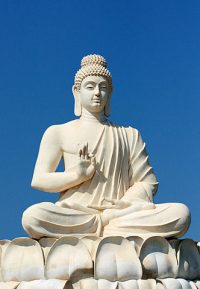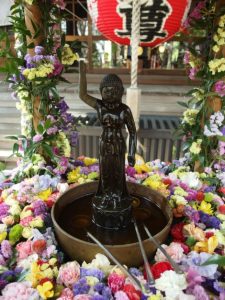Some time ago – years, now – I started a series of posts for the SWZ website trying to fill in some of the gaps in my own knowledge about the various figures in the Zen lineage who are venerated in our dedication during regular service. I managed to do the two I was most curious about – the sixth patriarch Daiken Eno (Huineng) and co-founder of the Soto school, Keizan Jokin. However, as so often happens, life got in the way and I didn’t take it further than that.
We’ve recently updated our dedication to include some of our female ancestors, and a few of our dharma sisters are going to post about the new names on the list. I’ve agreed to carry on in the meantime with some more posts about the original men on the list, in the hope that we’ll end up with a complete set.
And not that it’s at all intimidating, but I’m going to launch into it with the first name on the list: “The Great Master Shakyamuni Buddha.” 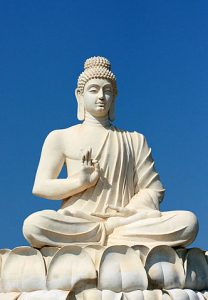
The life of the Buddha
I was going to cheat on this one and not give a full biography of the Buddha… but the more I read, the more I wanted to summarise things for myself, get them straight in my head. So I’m afraid you’re reading the result of a bit of my self-indulgence. The life of the Buddha is written about in many places, and for full details, please refer you to your favourite source. I did check out the Wikipedia article on the Buddha’s life[i] while preparing this, and it’s currently pretty substantial and a good read.
Here’s a quick sketch, though… I’ll break it down, as many have before, to the Buddha’s birth, growing up, renunciation, quest, enlightenment, teaching and death.
Birth & early life
Dates of the Buddha’s birth range from 563BCE to as late as 400BCE – historical evidence from the time is sketchy: the earliest records of the area are the Gandharan Buddhist texts which date from the first century BCE, so quite a gap! It is said that he was born in a grove in Lumbini as his mother, Maya, was trying to return to her family for the birth. Sadly, Maya died seven days after his birth, leaving Siddhartha to be raised by his aunt, Maha Prajnapati (the first female name in our dedications).
There are all sorts of legends around his birth – a mix of wonderful nonsense and some great traditions. Some Buddhist sects have even had ‘virgin birth’ stories (though they’re not that widespread). One Eastern legend says that two Dragon Kings rained down cool sweet water to bathe the baby Siddhartha, and this is echoed in the Japanese festival of Hana Matsuri on April 8: the Flower Festival, or Buddha’s Birthday. During the festival, a hydrangea tea is poured over statues of the baby Buddha. A more common motif of these stories is that on being born, the soon-to-be-Buddha took seven paces and declared, “Foremost am I in the world. This is the last birth. There is now no more coming to be.” [ii]
After his birth, it was prophesied that Siddhartha would be either a great ruler or a great sage; his father preferred the former of course, and so in order to ensure that his son was never prompted to ask the big questions about Life, the Universe and Everything, he was brought up in luxury, not knowing or seeing suffering. He was married to his cousin Yasodhara, and they had a son, Rahula. For the first 29 years of his son’s life, Siddhartha’s father’s plan seemed to be working!
Renunciation & quest
When he was 29, the Buddha left his palace with this servant Channa, and saw what have become known as The Four Sights: that of an old person, a sick person, a dead person and a holy person. Having been sheltered from this for so long, the realisation of the universality of suffering really shook Siddhartha to the core. After examining his life, he decided to leave his family, his obligations, his wealth… everything. Channa went out with him once more, and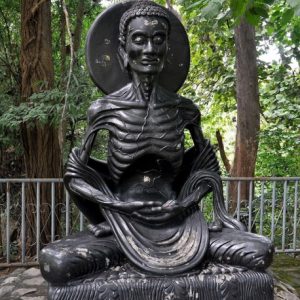 the Buddha became a seeker after truth, trying to understand the nature of suffering. He studied under two masters, both of whom wanted him to become their successor, but he still though he hadn’t quite “got it”. Thereafter, he joined with five others and practiced a series of extreme austerities, nearly dying in the process – it’s said that he was saved by a young village woman, Sujata, who fed him a rice soup (which must have seemed like manna!). He realised that asceticism wasn’t the way, either, and devised the idea of the ‘Middle Way’ of neither indulgence nor mortification.
the Buddha became a seeker after truth, trying to understand the nature of suffering. He studied under two masters, both of whom wanted him to become their successor, but he still though he hadn’t quite “got it”. Thereafter, he joined with five others and practiced a series of extreme austerities, nearly dying in the process – it’s said that he was saved by a young village woman, Sujata, who fed him a rice soup (which must have seemed like manna!). He realised that asceticism wasn’t the way, either, and devised the idea of the ‘Middle Way’ of neither indulgence nor mortification.
Enlightenment
One night soon after the Rice Pudding Incident (after which his five companions abandoned him in disgust at his luxurious ways – rice pudding! I ask you!), the Buddha vowed he would sit in meditation until he cracked it. He sat under a pipal tree – now known as Bodhi trees – and did some serious zazen. Perhaps. Again, there are wonderful stories about this night (or in some tellings, three nights or even 45 nights), including the temptations of the demon king, Mara. Depictions of the Buddha touching the 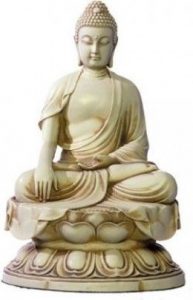 ground with one hand are a reference to this as he called upon the Earth itself to witness his enlightenment (the position is known as the “Earth witness mudra”), and it was this that finally banished the demon.
ground with one hand are a reference to this as he called upon the Earth itself to witness his enlightenment (the position is known as the “Earth witness mudra”), and it was this that finally banished the demon.
Towards the end of the night, as the morning star rose, he awoke and became the Buddha. He declared, “I, all beings, the great Earth, are the wisdom and virtue of the awakened one to thusness.”[iii] He was 35 years of age.
In the Zen tradition, we mark this on 8 December (Rohatsu), often by sitting throughout the night as the Buddha himself did.
Teaching
Traditionally, the Buddha had to be somewhat bullied into teaching – he was reluctant as he thought it would be a waste of his time. He was prevailed upon to change his mind, though – thanks to the deity Brahma Sahampati who allegedly managed to persuade him!
The first teaching he delivered, seven weeks after his enlightenment, is known as the “Setting into Motion the Wheel of the Dharma” (or the Dhammacakkappavattana Sutta[iv] as it is recorded in the Pali canon). It was delivered to the very five ascetics who had turned their backs on him a few months earlier, but who now recognised that the Buddha had experienced a significant realisation. In the Buddha’s first teaching, he outlined to them the Four Noble Truths and the Noble Eightfold Path, core teachings with which we are all familiar today. The five ascetics abandoned their previous austerities, and became his first five monks – the Sangha was born.
This was the start of a 46-year career as a teacher and the head of his new movement. For these decades, the Buddha and his followers travelled around the areas now known as Uttar Pradesh and Bihar in India, and the southern part of Nepal. A recent 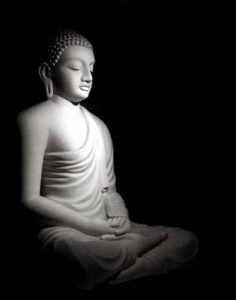 interesting account of some of this can be found in Stephen Batchelor’s Confession of a Buddhist Atheist,[v] in which he does a thoroughly modern job of trying to interpret from the earliest texts some of the political and social context of that period – Buddhist scriptures have always been less interested in the story of his life at that time, focussing entirely on recording his teachings.
interesting account of some of this can be found in Stephen Batchelor’s Confession of a Buddhist Atheist,[v] in which he does a thoroughly modern job of trying to interpret from the earliest texts some of the political and social context of that period – Buddhist scriptures have always been less interested in the story of his life at that time, focussing entirely on recording his teachings.
By the end of his life, the Buddha had presided over the successful establishment of a vibrant order of monks and nuns, he had expounded his Dharma to them and to many others, and had been the driving force behind the founding of a tradition that survives, in various forms, to this day.
Death / Parinirvana
When he was 81, it is said that the Buddha predicted his own death. His final meal – which may have been the cause of his death! – was either pork- or mushroom-based depending on who you believe, and it make him very ill very quickly. He had enough time to ensure that the person who cooked his dinner wasn’t blamed, ask if the monks and nuns had any final questions. There were none, so he made one final exhortation before dying:
All things are impermanent:
Strive on with diligence!
Or as we say in the evening gatha at the end of the day in the Zen tradition: “Let us awaken! Awaken! Take heed: do not squander your life.”
The role of the Buddha in Zen practice
More perhaps than any other Buddhist lineage, the teaching stories of the Zen school tend to feature historically later figures than the Buddha, and oddly there’s not all that much talk about him. That’s not to say that he’s ignored – the Sotoshu is firm that the figure of the historical Buddha is the primary image of Soto Zen,[vi] and naturally we do discuss his original teachings fairly often, but far less than other Buddhist traditions.
Further, of course, as each of us does jukai or tokudo, we are presented with a kechimyaku or lineage document, which traces our ancestry from the Buddha through the Buddha’s Indian successors, Chinese successors, Japanese successors and finally now Western successors, ending with our own name.
The Flower Sermon
The first link in that chain was established (or so Chinese Ch’an writers claimed some 1,500 years after the fact) during the Flower Sermon at Vulture Peak. The Buddha sat with his monks as he had so many times before, and they waited for him to speak. For a while, he said nothing – you can imagine the monks’ consternation. Then he silently lifted up a flower. None knew what to make of this, until one disciple, Mahakashyapa, smiled. The Buddha noted this, and said, “I possess the true Dharma Eye, the mind of Nirvana, that does not rest on words. This I entrust to Mahakashyapa.”
It’s really not important that this story, the founding myth of the Zen school, is made up. As you may know, it’s hardly the only bit of the lineage that is a touch fictional! However, as a living illustration, the raising of the flower continues to this day. My first teacher used to write letters to some of us while we were at university, and they all started, “I shin den shin,” or, “From my heart to your heart.” In each letter, she raised the flower. Each time Keizan Sensei talks to us or meets us in interview, the flower is again raised.
What will you do with this flower?
Right where you are
Perhaps one of the reasons that we emphasise the historical Buddha less in the Zen schools is that we stress so much how we find the Buddha here-and-now. Who is the Buddha? I am. How does the Buddha manifest his great enlightenment? He types on a computer, late at night, with the tinnitus ringing in his ears!
Making sense of the Buddha’s life
Still, the story of the Buddha is rich in narrative, symbol, lesson, for anyone who is looking for a pry-bar to investigate their own lives.
One example comes to mind: The conditions of the Buddha’s early life – surrounded by luxury, in denial of suffering, steadfastly ignoring the spiritual life – are a powerful metaphor for our modern lives. Never have we known such luxury, and never have we spent so much time and energy keeping unhappiness at bay (unsuccessfully, of course!).
I heard a line on the telly this evening – someone was talking about a child experiencing the death of a family member as “unthinkable” and it struck me quite hard how ridiculous that is, given the broad sweep of human history. It wasn’t very long ago that old age, sickness and death were in our faces all the time; nowadays we barricade the elderly in nursing homes (rather than our homes!), bring billions of pounds to bear to eradicate disease, and for the most part die neatly in some medical setting and hide the body from the children.
We are all young Siddharthas, surrounded by luxury and privilege. What will it take to truly jar us out of our complacency? What will our Four Sights be, that grab us by the head and shake our self-satisfaction or even our mild anxiety, and really give us a push into questioning our lives in some way?
For some of us, this has already happened – we have been driven into practice by some deep sense of lack or questioning, and perhaps this isn’t the most relevant part of the Buddha’s story. But the tale of this young Indian prince, turning his back on family, comfort and privilege to become a seeker and finally sage is long and detailed, and there’s certainly loads in there for any one of us to find ourselves in his narrative… and hopefully to find the Buddha at the heart of our own narratives, too.
[i] https://en.wikipedia.org/wiki/Gautama_Buddha
[ii] http://www.buddhanet.net/e-learning/buddhism/lifebuddha/2lbud.htm. Another popular version has him saying “In the Heavens above and on the Earth below, I alone am the World-Honoured One. All that exists in the Three Worlds is suffering, but I will bring comfort.” (http://www.btsd.net/Dharmamsg/2012/5-2012.html)
[iii] https://www.facebook.com/YokojiZMC/posts/10151298806772451 – this is Tenshin Roshi’s rendering of it. Others Zen sources have, “I, together with all beings, am simultaneously enlightened.” A more common rendering is: “Wonder of wonders! All beings just as they are whole and complete! All beings are endowed with Buddha-nature! But because of their deluded thinking, they fail to realize it.” The Dhammapada has something altogether different: “House builder, thou art seen. Thou shalt build no house again. All thy rafters are broken; thy ridgepole is shattered. The mind attains the unconditioned. Achieved is the end of craving.” (http://www.buddhanet.net/e-learning/buddhism/lifebuddha/2_1lbud.htm).
[iv] http://www.accesstoinsight.org/tipitaka/sn/sn56/sn56.011.than.html
[v] Batchelor, S. (2010). Confession of a Buddhist Atheist. Spiegl & Grau.
[vi] http://global.sotozen-net.or.jp/eng/what/Buddha_founders/dogen_zenji.html

